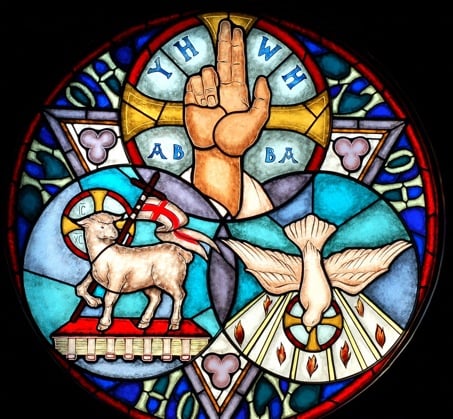The Word in Pictures
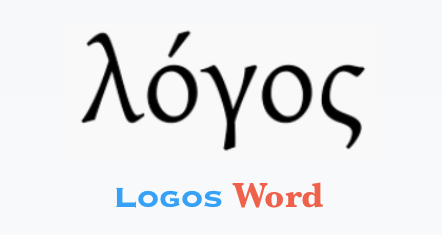
“ See, I lay a stone in Zion, a tested stone,
a precious cornerstone for a sure foundation;
Isaiah 28.16 NIV '84
The first verse of Genesis in its original God-breathed form has long been regarded by Bible-maths researchers as the most encoded words ever written. As this website displays, the first five verses of the English-language NIV '84 Bible can also lay claim to being encoded to a holographic degree. Both passages of text have been sitting since their creation like zip files waiting to be unpacked and read at the appointed time. [1]
A third portion of text, John 1.1 (TR)), is already known to combine with Genesis 1.1 (MT) to give the information to build a large numerical triangle displaying God's numerical signature. In this and future pages I will continue to explore John's opening verse, initially on its own, then in conjunction with the opening verse of the Hebrew Bible and finally with the opening five verses of the NIV Bible, which I call The Garden of Eden. The structures I uncover and reconstruct build on what has already been found and tell of a single Architect and Author of all of these verses and by extension all three texts and languages.
We begin on this page with John 1.1 itself. Before reading the rest of these pages readers might like to review G-triangle geometry and the creation of fractal snowflakes as pixellated images.
An Outline of John 1.1
Here is the opening verse of John's gospel, from the Textus Receptus and from which several early Bibles were translated.

I noticed several years ago that if the standard values of the final and central words of Genesis 1.1 are subtracted from that of its first word, the result is 216, the number of counters around the perimeter of triangle 2701, the standard value of the entire verse.
The standard value of John 1.1, 3627, is a trapezium. I recently discovered that if the same procedure used on G1.1 is followed with J1.1, but in reverse (the first and central words subtracted from the final word) the result is 260, which is the outline of trapezium 3627. This is shown in the diagram below.
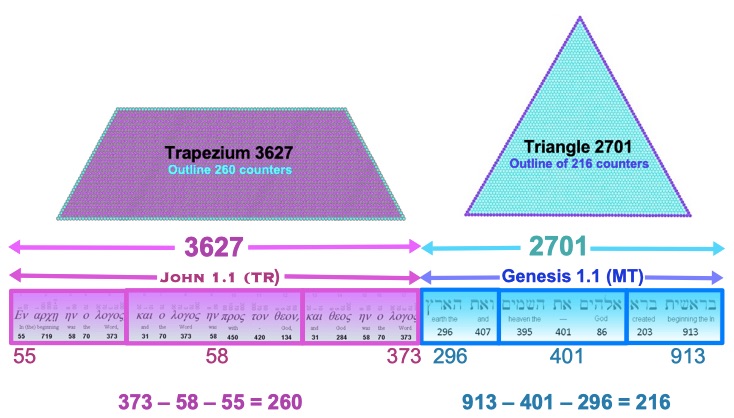
if we now take the sum and difference of these numbers, we make an amazing discovery.
260 + 216 = 476
260 - 216 = 44
The Messiah (s) = 476
The Messiah (r) = 44
So this finding further underlines the meaningful connections between these two seminal verses, which are seen to be two parts of a geometric whole: triangle 6328. This is easily formed by placing triangle 2701 atop trapezium 3627.
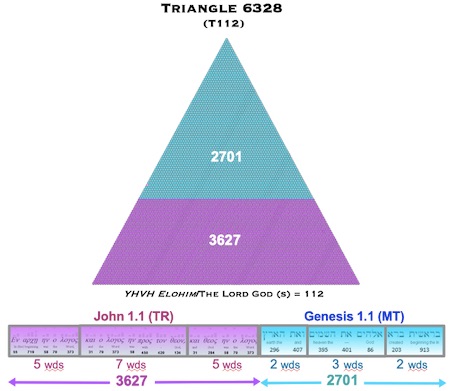
Triangle 6328 is 112th in the sequence and 112 is the value of the Hebrew words YHVH Elohim/The LORD GOD.
Mirroring and symmetry are important concepts in the code, leading to further mathematical connections. For another example, if we add to 2701 its mirror value of 1072, we get 3773, suggesting the only factors of 2701, which are 37 and 73. [2]
This is a promising start, so lets continue to unpack John's mysterious opening verse.
The Word in Three Parts
As shown in detail below I have partitioned the seventeen words of John 1.1 from the Textus receptus into a 5-7-5 pattern, based on the grammatical structure of the verse. This splits 3627 into the numbers 1275, 1536 and 816 and gives us the following basic template:

The template approximately mirrors the 2-3-2 grouping in Genesis 1.1 that hold the first iterations and starting triangle for the Koch Snowflake and antisnowflake (millennia before fractal geometry was discovered), which the code utilises as a metaphor for life and growth.
Bearing that in mind let's take a look at the number 1275.
1275
This happens to be the 50th triangle and it sits at the head of John 1.1 like an obelisk. All numerical triangles can be taken one or more steps towards an antisnowflake, and triangle 1275 can be taken one step, creating trefoil 867.
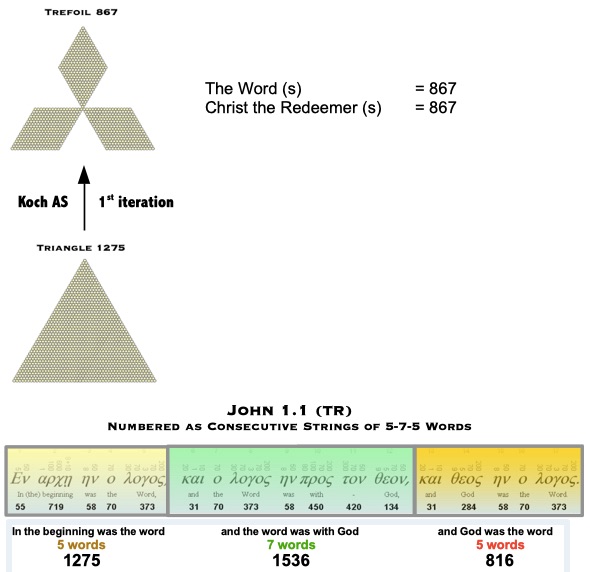
Both in number and form trefoil 867 symbolises the Word, its generating triangle sitting at the head of the verse that introduces it to the world. Geometrically, the trefoil represents life ('trefoil' means 'three-leaved plant'), and its triangular geometry symbolises our triune God, Creator of life. (24/9/22) I just found a beautiful identity to add to the above, giving this trio, all with equal numerical weight and all linked to the trefoil, a word meaning three-leaved plant and therefore symbolising God's gift of life:
The Spirit (c) ..................= 867
The Word (s) .................= 867
Christ the Redeemer (s) = 867
Triangle 1275 is also an elemental triangle for a larger triangle with 11476 counters. This is the 151st in the sequence. [3]
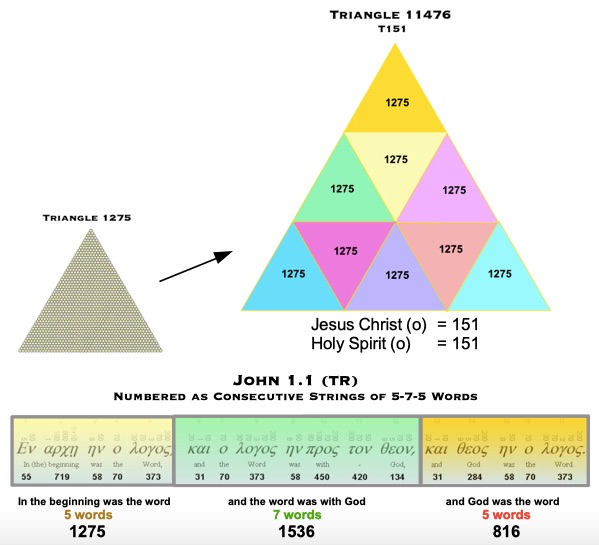
Triangle 11476 is a G-triangle and self-reflects to form star 15301, the 51st in its sequence.
Our Lord Jesus (r) = 51
The core and satellite triangles of T151 are T76 and T75
Lord God (o) ........= 75
The Holy Spirit (r) = 76
Notice how these ancient Greek words contain information that can only be read in modern English. [4]
1536
1536 is the superficial area of cube 4096, either as squared units in solid geometry or as the number of surface spheres that are seen when each side is viewed face-on.
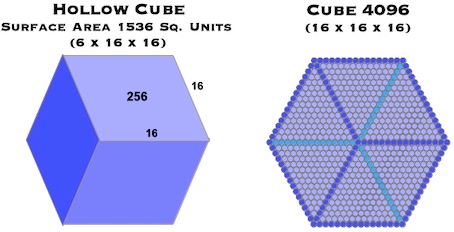
Cube 4096 has the unique property of being a square, cube, tesseract and two further hypercubes. However, it's principal interest here is that its two outer shells together sum to 2368, standard value of 'Jesus Christ' in Greek. They encompass cube 1728, the cube of 12, which suggests the dimensions of the New Jerusalem of 12,000 stadia on a side. The separation of cube 4096 into the smaller cube and cubic shell is shown below (it reminds me of a hazelnut being shelled). Both numbers can be related to the Word.
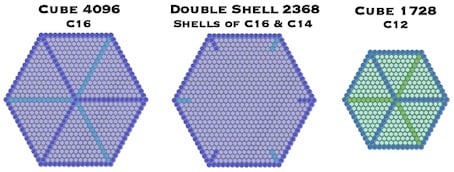
![]()
The Word of the Lord God (c) ................= 1728
So as with 1275, this initial exploration of the geometry of the number 1536 leads us to Jesus Christ, the Word of God. [5]
4096 is also 8 x 8 x 8 x 8 and therefore a tesseract, the 4D equivalent of a cube. Just as a hollow cube can unfold to form a 2D cross, so a 'hollow' tesseract can unfold into a 3D cross. The 'surface' of tesseract 4096 is made of 8 cubes of 512 spheres, yielding 4096 again (8 x 512 = 4096). These can unfold to form 3D-cross 4096 - and when you look at this object straight on, you see a 2D cross of 1536 units. All this is shown below.
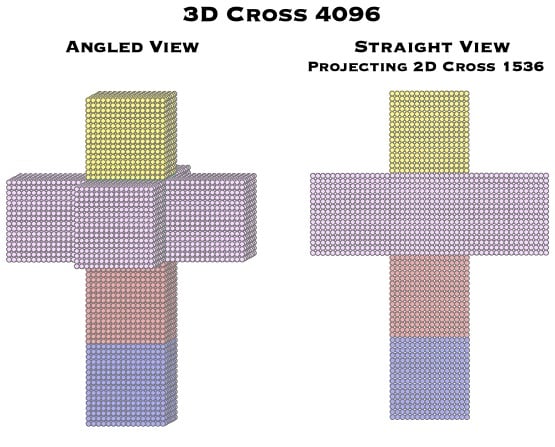
The 3D cross, made famous by Dali's Crucifixion (Corpus Hypercubus), is one of 261 possible configurations, known as 'nets', into which the tesseract will unfold. [6] Interestingly, this is the difference between 1536 and 1275, the previous word string.
1536 - 1275 = 261, number of 3D nets for a tesseract
It's worth remarking that if each cube in the 3D cross were replaced by its cubic shell of 296 units, the sum would again give us 2368, 'Jesus Christ' in Greek.
816
1536 counters will form a collar of rhombii, within which a crown of six triangles can be placed to create a ring of 2352 counters. This crown has 816 counters, the s.v. of the third clause in John 1.1.
Hexagonal Ring of 2352 Units
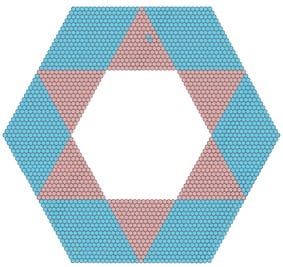
The enclosed space can be filled by a hexagon of 817 counters that completes hexagon 3169. 817 itself is the difference between 1536 and 719, the second word of the verse and the word with the highest individual value.
So, satisfyingly, we have fashioned hexagon 3169 from three numbers found within John 1.1 itself. All this is illustrated below.
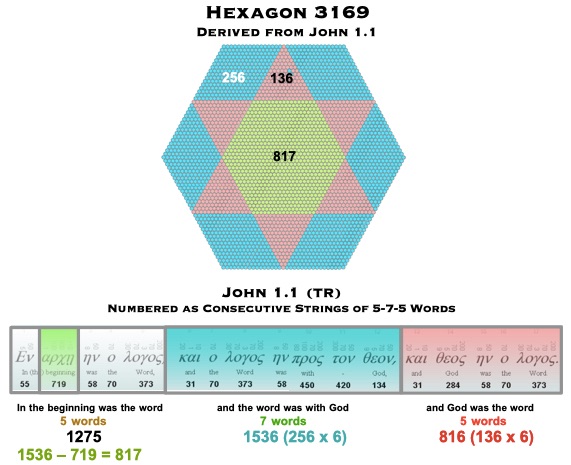
Hexagon 3169 can now itself be crowned with 3168 untis to give star 6337. 3168 is 'Lord Jesus Christ' in Greek and each component triangle has 528 counters, this being the full value in Hebrew of Yehoshua/Jesus. [7]
Crown 3168
6 x triangle 528 (T32)
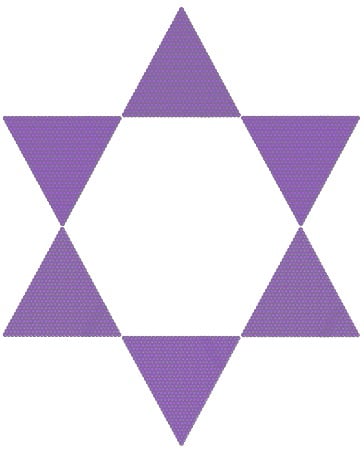

Yehoshua/Jesus (full) .......................................= 528
Christ (r) .............................................................= 32
So this crown contains numbers that represent the Lord in Hebrew, Greek and modern English! The outline of each triangle is 93, which is the ordinal value of 'the Word'.. . . .
.
Symmetrical Strings
The three word strings can be paired, giving us two longer, overlapping strings of twelve words each.
1275 + 1536 = 2811 (1st 12 wds)
1536 + 816 = 2352 (last 12 wds)
Both of these sums are trefoils, cut from important template triangles. For trefoil 2811, these are triangle 6105 (T110) and triangle 2775 (T74):
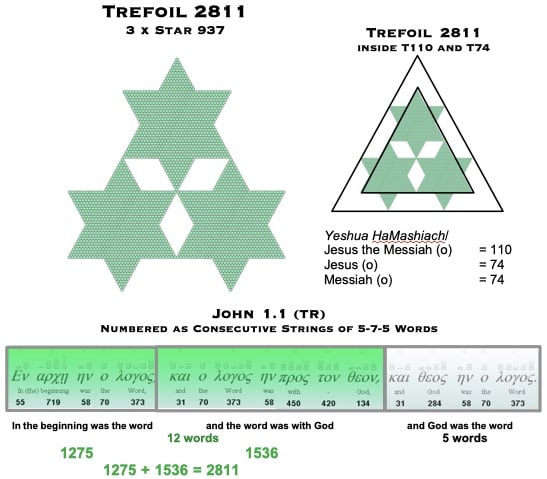
For trefoil 2352, the generating triangle is 3486 (T83):
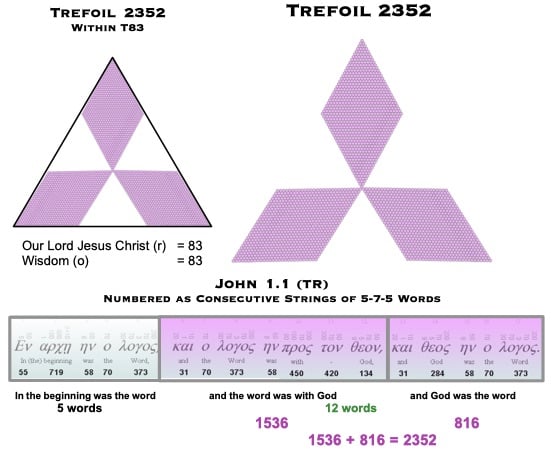
In Greek and Hebrew the number 83 is also associated with the ideas of the Holy Spirit, covenant, bread and the altar of the Lord, all of which are related to Jesus Christ.
A Final Picture
Here, then, is a summary of the given geometric features of John 1.1, as revealed by a 5-7-5 partitioning of the verse's seventeen words.
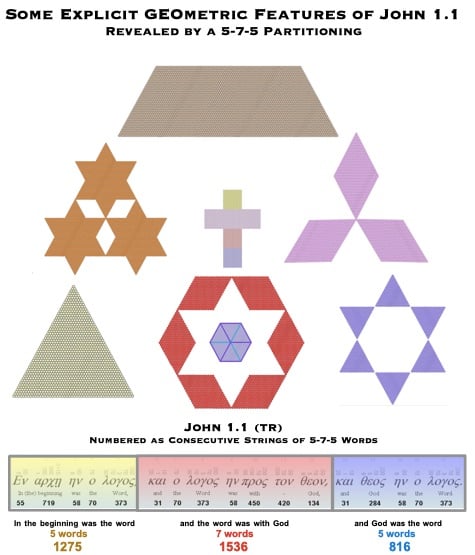
In John 1.3 we read
"Through him all things were made . . . ."
This garden of geometric wonders planted in the text (and the further geometry simple manipulations reveal) enriches the meaning of this sweeping statement. [8]
A Final Word
Finally, noting the importance of English gematria in unlocking these codes, the numerical sum of John 1.1, 3627, is 39 x 93.
The Word (o) = 93
The Word (r) = 39
We already found 867, the standard value of 'The Word', as the trefoil derived from triangle 1275, which sits at the head of the verse. So the standard, ordinal and reduced values of the English title 'The Word' are all to be found in the very words that introduce the concept to Christians.
Addendum (16/9/22)
In his webpage Putting the Record Straight, Vernon Jenkins discovered that the numbers of chapters in the Bible, 1189, can be portrayed as an hourglass figure. Remarkably, this is also true of the Old Testament, with 929 chapters. Both figures are below.
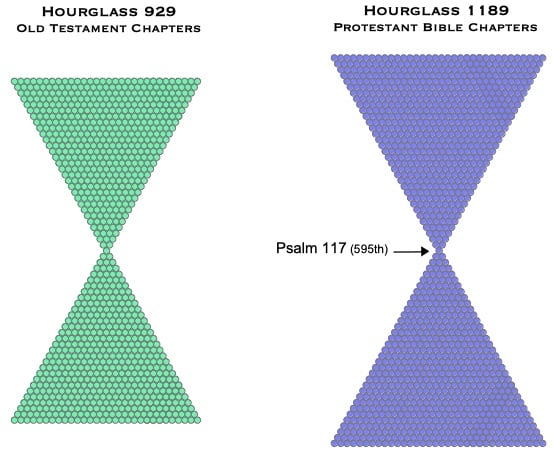
Hourglass 929 is based on triangle 465 and hourglass 1189 based on triangle 595. The 595th and central biblical chapter is Psalm 117, the shortest in the entire Bible. This is suggested by the hourglass having a single counter at its centre!
John 1.1 contains a stunning little code based on two more hourglass figures. Looking at John, if we start with the 5-7-5 pattern but split the central word string at word 4, we now have a 5-4-3-5 pattern and neatly split the phrase into 'and the word was' and 'with God'. It also splits 1536 into two numbers, 532 and 1004. These allow two new numbers to be created, both hourglass figures. All of these new numbers repeat the theme of the verse itself: the Word (Spirit and made flesh) and God, and their decoding again requires modern English, as well as biblical Hebrew and Greek.
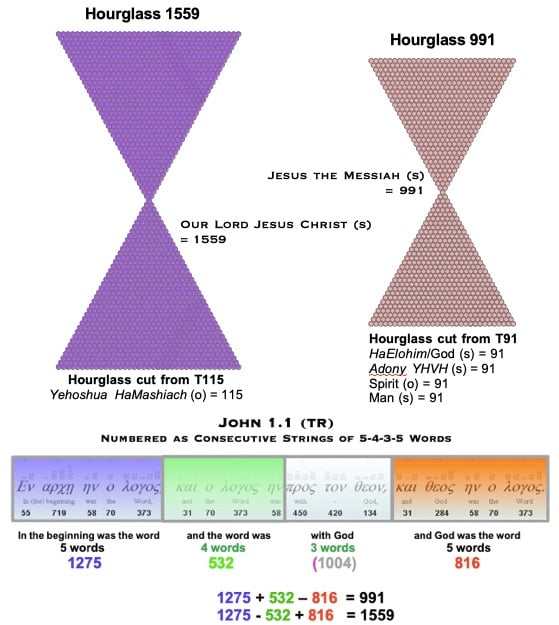
Note that each hourglass is related though gematria to titles we use for the Saviour, with further connections through the template triangles from which each figure can be cut.
The two numbers that 1536 splits into, 532 and 1004, are the values of the Greek phrases for 'and the word was' and 'with God'. In English, 1004 is also the value of this formal title for the Word.
The Word of God (s) = 1004
The calculations performed here are exactly the same as those that revealed Star of David 937/469 inside the Creation Triangle, but performed in reverse, as with the encoding of the outline figures. The next page reveals the purpose for this reversal.
The next page in this series is The Creation Seal.
Bill Downie 30/8/22
Last Updated 16/9/22
Notes
1. It is holographic in another sense too. A holograph is a manuscript handwritten by the person named as its author. The entire code could then be considered as the handwriting of the Bible's Author! A good exploration of the idea of our universe as a hologram is The Holographic Universe, by Michael Talbot.
2. These are the only two-digit reflective numbers with this property. In addition they are both hexagram numbers and are encoded together as a star of stars in the word value of Genesis 1.1 (MT). 37 is also a centred hexagon and with star 73 forms Star of David 73/37. 73 is a trefoil number too, so together, 37 and 73 display and lie at the heart of the snowflake geometry that is the foundation of the English, Greek and Hebrew codes and which reveals them as three interlinked parts of one Code.
3. The triangles are placed around a central counter, so T151 is (9 x 1275) + 1.
4. Three of the four numerical substitution systems employed by the New Bible Code, standard, ordinal and reduced, are based on the equivalent Hebrew and Greek systems.
5. The combined system of gematria is the sum of the standard, ordinal and reduced systems. I was taught it in 2003 through an unusual sequence of events, described in my book.
6. See https://en.wikipedia.org/wiki/Tesseract
7. The full value in Hebrew is the standard value of the Hebrew letters in a word or phrase written as words themselves. So aleph can be the character aleph, with gematria 1, or the word aleph, lamed, pey, with gematria 1 + 30 + 80 = 111.
8. This is another example of the code's use of fractal geometry as a metaphor for life and growth.
